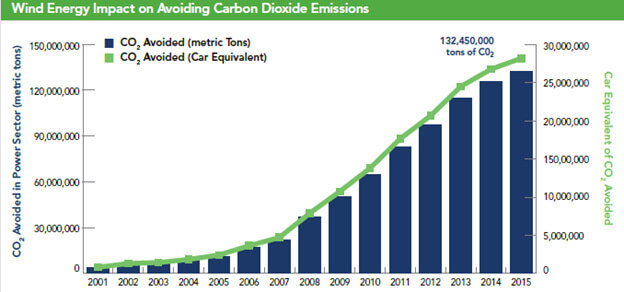U.S. wind farms reduced electric power sector carbon dioxide emissions by an estimated 132 million metric tons in 2015, according to the American Wind Energy Association’s (AWEA) forthcoming annual U.S. wind industry market report. Those avoided emissions are equal to that from 28 million cars, or more than 6% of all carbon dioxide (CO2) emissions from U.S. electricity generation last year.
Wind energy also greatly reduces a variety of health-harming air pollutants, including smog-causing sulfur dioxide (SO2) and nitrogen oxides (NOx), which helps reduce rates of asthma and other respiratory issues. Electricity generated by wind in 2015 displaced an estimated 176,000 metric tons of SO2 and 106,000 metric tons of NOx, representing $7.3 billion in avoided health costs last year alone.

“Americans will be able to breathe easier and live longer thanks to clean energy produced by American wind power,” said Tom Kiernan, CEO of AWEA. “Clean air benefits from wind power totaled $7.3 billion last year, without even including the value of carbon savings, and the industry also attracts thousands of quality jobs and billions of dollars in private investment to the U.S. economy. With wind power, states don’t have to make a trade-off between clean air and strong economic growth.”
“Unhealthy air is hazardous to our families and even can threaten life itself,” according to the American Lung Association’s Healthy Air Campaign. “Power plants directly emit a long list of harmful pollutants,” the campaign’s website says, “and electric utilities also remain the nation’s largest industrial source of carbon dioxide, a significant contributor to global warming.”
Accordingly, the American Lung Association has adopted as one of its goals the transition to a clean energy future “to protect all people from the harm of air pollution.” It includes “reforms to transmission and distribution policies that will encourage the expansion and delivery of clean, renewable, non-combustion energy resources” such as wind energy.
The tons of SO2 and NOx pollution avoided just in 2015 carry a public health monetary value of more than $5.4 billion and $1.8 billion, respectively, based on cost assumptions provided by a Harvard School of Public Health study. At the start of 2016, there were 9,400 MW of wind-power capacity under construction, which is expected to reduce another 23 million metric tons of CO2 emissions each year when operational, and cut overall power sector CO2 emissions by an additional one percent.
The 132 million metric tons in CO2 reductions in 2015 are equivalent to eliminating all power sector carbon dioxide emissions in Kansas, Nebraska, Oklahoma, and Colorado last year.
Data released today is an early look at AWEA’s 2015 U.S. Wind Industry Annual Market Report, set for release this year on April 12 in Denver. It will provide a comprehensive update on the state of the U.S. wind market, job numbers, state-by-state comparisons, and more.
Wind power displaces generation from power plants using traditional fuel sources, and thus reduces greenhouse gas emissions and other air pollutants. A typical new wind turbine will avoid over 4,200 metric tons of CO2 emissions every year, the equivalent of nearly 900 cars’ worth.
Wind energy is the most cost-effective energy source to comply with the Clean Power Plan, the nation’s first-ever rule to reduce carbon emissions from existing power plants, according to the government’s Energy Information Administration, Wall Street investment firm Lazard, and other analysts. While the U.S. Supreme Court recently issued a temporary stay of the Plan, many states and utilities have already indicated they continue to plan for generation changes and have recognized carbon reductions as inevitable.
Total U.S. power sector emissions fell to their lowest annual level since 1995 last year, according to the Business Council for Sustainable Energy (BCSE) and Bloomberg New Energy Finance’s recently released fourth annual Sustainable Energy in America Factbook. Even while America has greatly reduced electric sector carbon pollution, electricity rates across the U.S. have remained 5.5% lower than they were in 2009.
Wind produced over 190 million megawatt-hours of electricity in the U.S. last year, enough to power 17.5 million typical U.S. homes, making the U.S. number one in the world in wind energy production.
Wind energy could grow to supply 20% of U.S. electricity by 2030 and 35% by 2050, according to the 2015 Wind Visionreport by the U.S. Department of Energy (DOE). Cumulatively by 2050, the DOE estimates wind could avoid $400 billion in climate change damages and save an additional $108 billion in public health costs by cutting other air pollutants, including preventing 22,000 premature deaths.
AWEA
www.awea.org
Filed Under: News, Safety




